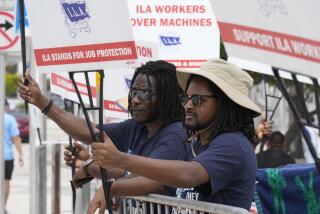Cargo Resumes Moving at Ports
- Share via
Billions of dollars’ worth of cargo that piled up at West Coast ports during the 10-day shutdown began moving out across supply chains Thursday--but not without glitches.
Meanwhile, representatives of the International Longshore and Warehouse Union and the Pacific Maritime Assn. employers group said they expected negotiations with a federal mediator to resume next week.
As work at harbors from San Diego to Seattle resumed Thursday, shipping companies and freight forwarders were scrambling to locate empty truck trailers, which were in short supply because seagoing containers were piled on them during the lockout.
Railroads were hard pressed to handle the demand. Although most containers move by truck, the rails have become a critical piece of the containerized shipping supply chain. With goods undeliverable during the lockout, rail carriers moved their equipment east, noted Steve Stallone, a spokesman for the ILWU.
Stallone said that in Oakland alone there are 36 ships in port, each with hundreds of rail containers aboard. But railroad officials are accepting only 180 containers a day, he said.
Union Pacific Railroad, one of the nation’s leading carriers, brought about 90 locomotives to Southern California in anticipation of Wednesday’s opening and expects to operate at least 30% more trains than normal from the West Coast in the coming days, according to spokesman Mike Furtney.
“The best thing we can do is tell everybody to stay calm and wait for the situation to catch up,” he said.
The West Coast’s 29 ports opened Wednesday night after a federal judge granted President Bush’s request for a temporary injunction under the Taft-Hartley Act, launching an 80-day cooling-off period for both sides.
The Pacific Maritime Assn., representing shipping lines and terminal operators, locked out the ILWU on Sept. 29, claiming the union was engaging in disruptive work slowdowns to protest stalled contract talks.
Pacific Maritime Assn. spokesman Steve Sugerman described the work pace as sluggish Thursday, and said the group continues to monitor the ILWU’s activity to determine whether there are any orchestrated slowdowns. The group is prepared to seek court sanctions against the ILWU if it believes a slowdown is in effect.
Union leaders, who have vowed to “work safe” in the wake of the deaths of five ILWU members on the waterfront this year, say the slow pace is a result of a backlog of containers and a shortage of staffing and equipment.
Although containers were moving out, port and shipping executives warned that the backlog of tennis shoes, computer parts, Halloween decorations and other goods was so huge that it would take weeks before the transpacific supply chain was back to normal.
“It’s not unreasonable to expect that we’re going to feel the impact of this work stoppage for at least another six weeks,” said Robert Kleist, an advisor to Taiwan-based Evergreen.
With each day of additional congestion, the bill for the port closure mounts.
Giant clothing retailer Gap Inc. on Thursday warned that its fourth-quarter earnings could be 50% below expectations because of the port closure. And the Los Angeles County Economic Development Corp. estimated that the 10-day shutdown cost the U.S. economy at least $5 billion, nearly half of that in California.
Even with everyone working overtime to get ships on their way, it will take weeks to work through the backlog because there are more vessels at sea, said Dick McKenna, executive director of the Marine Exchange at the ports of Los Angeles and Long Beach.
As the day began Thursday, hundreds of workers crowded into the ILWU hiring hall in Wilmington and hundreds of trucks lined up across the harbor at Pier 400, the largest shipping terminal in the world.
Paul Orcutt of Long Beach, a union mechanic, said he is concerned about how the next several weeks will play out. Orcutt was in the first group of workers allowed back into Pier 400. Upon entering, he said, officials of the terminal company handed his group of mechanics a list of more than 50 vehicles and cranes that needed repairs.
“The shipping companies will have to understand that we are doing the best job possible with what they have given us to work with,” he said. “We all want to do our job.”
Across the U.S., businesses wondered when their freight would be delivered.
Miranda Su, vice president of sales and marketing for Irvine-based technology firm Iogear Inc., said she was desperate to get her firm’s containers of computer peripherals and networking equipment off a ship in Long Beach. If she fails, clients such as Fry’s Electronics Inc. and Amazon.com Inc. will be caught without some of Iogear’s most popular products.
One industry particularly hard hit by the port closure was the import automakers. Gardena-based Nissan North America and Torrance-based Toyota Motor Sales USA Inc. are predicting U.S. sales could drop by as much as 15% in October because of shortages of popular vehicles they import from Japan.
Honda Motor Co. said Thursday that it will close three of its U.S. manufacturing plants for an undetermined period because of parts shortages that developed while the ports were closed.
Times staff writers John O’Dell and Dan Weikel contributed to this report.
More to Read
Sign up for Essential California
The most important California stories and recommendations in your inbox every morning.
You may occasionally receive promotional content from the Los Angeles Times.











